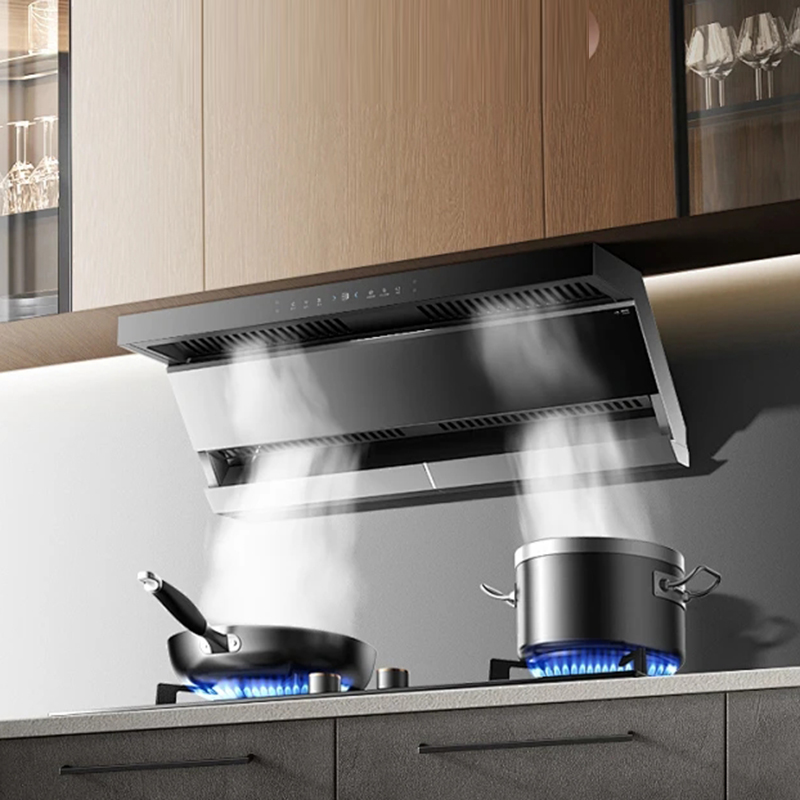Range hood bleed occurs when cooking fumes are not effectively exhausted to the outside and instead flow back into the kitchen or indoors through other channels. This bleed not only affects indoor air quality but can also cause grease accumulation in the kitchen environment and even lead to health problems. Therefore, addressing kitchen hood bleed is crucial. Below is a detailed analysis of the causes, effects, and solutions for range hood bleed.

1. Ensure the correct installation location for the kitchen hood.
When installing the range hood, ensure the proper distance between the hood intake and the stovetop. Generally, the bottom of the hood should be 65-75 cm above the stovetop. This minimizes fumes from escaping and effectively absorbs them.
2. Choose the appropriate airflow rate and model.
When choosing a kitchen hood, select the appropriate airflow rate based on the size of your kitchen and your cooking habits. Generally, homes with larger kitchens or those that cook with more greasy food should choose a range hood with higher airflow rates. Range hood exhaust volume is typically measured in cubic meters per hour (m³/h). Choosing a range hood should be based on this exhaust volume.
3. Regularly clean the kitchen range hood and flue.
Long-term accumulation of grease inside the range hood and flue is a major cause of smoke leakage. To maintain effective range hood exhaust, the range hood and flue should be cleaned regularly. Generally, the filter should be cleaned monthly, and the flue should be cleaned at least once a year.
4. Check the range hood flue for unobstructed flow.
Regularly check the flue for patency to ensure it is free of blockage. Flue cleaning services can be used to remove accumulated grease and ensure smooth exhaust.
5. Optimize the exhaust duct design.
The flue duct should be designed to be as simple as possible, avoiding excessive lengths or bends. If there are any problems with the flue design, redesign the duct or replace it with a suitable duct to improve exhaust efficiency. The flue diameter should also meet standards; a duct that is too small may affect exhaust efficiency.
6. Check the environment outside the exhaust vent.
Ensure the exhaust vent is not blocked by external obstacles. Check the area around the exhaust vent to ensure it is not blocked by branches, debris, or other objects. If possible, install an exhaust backflow prevention device to prevent backflow of cooking fumes.
7. Improve the airtightness of the kitchen.
Improving the airtightness of the kitchen and reducing air exchange between the kitchen and the outside can effectively prevent cooking fumes from escaping. Use sealing strips to strengthen the seals of doors and windows to prevent cooking fumes from entering other areas through gaps.
8. Replace with a more efficient range hood.
If your range hood is of poor quality or lacks sufficient airflow, consider replacing it with a more efficient and powerful one. Choosing a higher-quality, more powerful kitchen hood can significantly improve exhaust efficiency and reduce the possibility of smoke leakage.
Smoke leakage from kitchen hoods can be caused by many factors, including the installation location of the range hood, the design of the flue, the airflow of the range hood itself, and blockages in the exhaust duct. Solving this problem requires multiple approaches, including ensuring the range hood's wind power is strong enough, the exhaust duct is unobstructed, the kitchen environment is well sealed, and the range hood and flue are cleaned regularly. These measures can not only effectively solve the problem of range hood smoke leakage, but also improve the air quality in the kitchen and reduce the harm of oil smoke to health.


